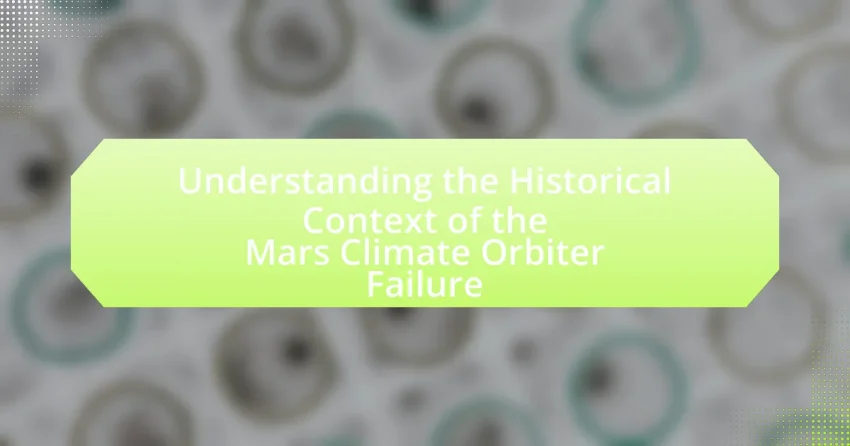The Mars Climate Orbiter failure serves as a critical case study in engineering miscommunication, primarily resulting from a mismatch in measurement units between NASA and Lockheed Martin. This incident led to the orbiter’s disintegration upon entering the Martian atmosphere due to a navigation error. The article outlines the mission’s objectives, the engineering decisions that influenced its design, and the key events leading to its failure. It also discusses the broader implications for future space missions, including changes in NASA’s engineering practices and communication protocols, as well as the lessons learned that emphasize the importance of standardized measurements and effective collaboration among teams.

What led to the Mars Climate Orbiter Failure?
The Mars Climate Orbiter failure was primarily caused by a navigation error due to a mismatch in measurement units between the teams at NASA and the contractor, Lockheed Martin. Specifically, NASA’s team used metric units while Lockheed Martin provided data in imperial units, leading to a miscalculation of the spacecraft’s trajectory. This error resulted in the orbiter entering the Martian atmosphere at a much lower altitude than intended, ultimately causing it to disintegrate. The incident highlights the critical importance of consistent unit usage in engineering and space missions.
What were the primary objectives of the Mars Climate Orbiter mission?
The primary objectives of the Mars Climate Orbiter mission were to study the Martian climate, atmosphere, and surface changes, as well as to provide data for future Mars missions. Specifically, the mission aimed to analyze the Martian weather patterns, map the surface features, and assess the seasonal changes in the atmosphere. The mission was designed to enhance understanding of Martian meteorology and contribute to the knowledge necessary for future exploration, including potential human missions. These objectives were grounded in the need for comprehensive data to inform subsequent missions and scientific inquiries about Mars.
How did the mission goals influence the design and engineering of the spacecraft?
The mission goals significantly influenced the design and engineering of the Mars Climate Orbiter by prioritizing atmospheric data collection and climate analysis of Mars. These objectives necessitated the incorporation of advanced instruments, such as a spectrometer and a camera, which were specifically designed to gather detailed information about the Martian atmosphere and surface. The engineering decisions, including the spacecraft’s trajectory and thermal protection systems, were also tailored to ensure optimal performance during the mission’s critical phases, such as entry and data transmission. The failure to adhere to the specified engineering units, as highlighted in the investigation report, underscores how misalignment between mission goals and engineering execution can lead to catastrophic outcomes, ultimately resulting in the loss of the spacecraft.
What scientific questions was the mission aiming to answer?
The Mars Climate Orbiter mission aimed to answer scientific questions regarding the Martian atmosphere, climate, and surface conditions. Specifically, it sought to investigate the seasonal weather patterns on Mars, the distribution of water ice, and the overall climate dynamics of the planet. The mission’s objectives included understanding the role of dust storms in Martian weather and assessing the potential for past or present water on the surface, which is critical for evaluating Mars’ habitability. These questions were essential for advancing knowledge about Mars and informing future exploration efforts.
What were the key events leading up to the failure?
The key events leading up to the failure of the Mars Climate Orbiter include a critical miscommunication between teams regarding measurement units and a lack of rigorous testing protocols. Specifically, the navigation team at NASA used imperial units (pounds) while the engineering team at Lockheed Martin used metric units (newtons), resulting in a navigation error that caused the spacecraft to enter the Martian atmosphere at an incorrect angle. This misalignment ultimately led to the loss of the orbiter on September 23, 1999, when it disintegrated upon entry. The failure was compounded by insufficient oversight and verification processes, which failed to catch the unit discrepancy before the mission commenced.
What were the critical milestones in the mission timeline?
The critical milestones in the Mars Climate Orbiter mission timeline include the launch on December 11, 1998, the successful Mars orbit insertion on September 23, 1999, and the subsequent loss of the spacecraft due to a navigation error caused by a mix-up between metric and imperial units. The launch marked the beginning of the mission, while the orbit insertion was intended to initiate the spacecraft’s scientific operations. However, the failure to achieve the correct orbit resulted in the loss of the orbiter, highlighting the importance of unit consistency in engineering and mission planning.
How did the engineering decisions impact the mission’s trajectory?
Engineering decisions significantly impacted the Mars Climate Orbiter’s trajectory by leading to a miscalculation of the spacecraft’s navigation and control systems. Specifically, the use of imperial units by one team and metric units by another resulted in a failure to accurately determine the spacecraft’s position and velocity. This discrepancy caused the orbiter to enter the Martian atmosphere at a much lower altitude than intended, ultimately leading to its destruction. The mission’s trajectory was thus compromised due to these critical engineering oversights, which highlighted the importance of consistent unit usage and thorough communication among engineering teams.
What role did communication play in the failure?
Communication played a critical role in the failure of the Mars Climate Orbiter by contributing to a significant misunderstanding between teams regarding measurement units. Specifically, the navigation team at NASA used imperial units, while the engineering team at Lockheed Martin employed metric units, leading to a miscalculation of the spacecraft’s trajectory. This miscommunication resulted in the orbiter entering the Martian atmosphere at an incorrect angle, ultimately causing it to disintegrate. The incident highlights the importance of clear and consistent communication in engineering projects, particularly in complex missions like space exploration.
How did the collaboration between different teams affect the mission?
The collaboration between different teams significantly impacted the Mars Climate Orbiter mission by leading to a critical miscommunication regarding unit measurements. The engineering team at NASA’s Jet Propulsion Laboratory used metric units, while the team at Lockheed Martin utilized imperial units, resulting in the spacecraft entering the Martian atmosphere at an incorrect angle. This misalignment ultimately caused the loss of the orbiter in 1999. The failure highlighted the necessity for clear communication and standardized protocols among collaborating teams in complex missions, as evidenced by the subsequent implementation of stricter guidelines for inter-team communication in future projects.
What were the communication protocols in place during the mission?
The communication protocols in place during the Mars Climate Orbiter mission included the use of the Deep Space Network (DSN) for data transmission and command sequences. The DSN, operated by NASA, facilitated communication between the spacecraft and mission control, ensuring that telemetry data was sent back to Earth and commands were relayed to the orbiter. Additionally, the mission employed a series of standardized communication formats and error-checking procedures to maintain data integrity and reliability throughout the mission. These protocols were critical for monitoring the spacecraft’s status and executing mission objectives effectively.

How did the Mars Climate Orbiter Failure impact future missions?
The Mars Climate Orbiter failure led to significant changes in mission planning and execution for future space missions. Following the loss of the orbiter in 1999 due to a navigation error caused by a mix-up between metric and imperial units, NASA implemented stricter engineering protocols and enhanced communication standards to prevent similar mistakes. This incident prompted the establishment of the Mars Exploration Program, which emphasized rigorous testing and validation processes for spacecraft systems. Additionally, the failure underscored the importance of cross-checking data formats and units among teams, leading to improved collaboration and integration practices in subsequent missions, such as the Mars Exploration Rovers and the Mars Science Laboratory.
What lessons were learned from the Mars Climate Orbiter failure?
The Mars Climate Orbiter failure taught critical lessons about the importance of consistent unit standards in engineering and the necessity of thorough communication among teams. The spacecraft was lost due to a failure to convert between metric and imperial units, which resulted in a miscalculation of its trajectory. This incident highlighted the need for rigorous checks on unit conversions and emphasized that all teams involved in a project must adhere to the same measurement standards to prevent costly errors. Additionally, it underscored the importance of clear communication and documentation practices within project teams to ensure that all members are aligned on technical specifications and operational procedures.
How did the failure influence NASA’s engineering practices?
The failure of the Mars Climate Orbiter significantly influenced NASA’s engineering practices by prompting a thorough reevaluation of project management and communication protocols. Following the incident, NASA implemented stricter guidelines for unit testing and verification processes to ensure that all engineering teams adhered to consistent measurement standards, particularly regarding metric and imperial units. This shift was evidenced by the establishment of the “Lessons Learned” program, which aimed to document failures and successes to improve future missions. Additionally, NASA increased emphasis on interdisciplinary collaboration, ensuring that engineers, scientists, and project managers worked closely together to mitigate risks and enhance mission success rates.
What changes were implemented in subsequent Mars missions?
Subsequent Mars missions implemented several key changes to improve mission success and data accuracy. Notably, NASA’s Mars Exploration Program adopted a unified metric system for all spacecraft, addressing the Mars Climate Orbiter failure caused by a mix of imperial and metric units. Additionally, enhanced communication protocols were established to ensure better data transmission and error-checking processes. The use of more robust engineering practices, including rigorous testing and validation of software and hardware, was also emphasized to prevent similar failures. These changes were validated by the successful landing of the Mars Science Laboratory, Curiosity, in 2012, which demonstrated improved mission design and execution.
What were the broader implications for space exploration?
The broader implications for space exploration following the Mars Climate Orbiter failure include heightened awareness of the importance of engineering standards and inter-agency communication. The loss of the orbiter, which occurred due to a failure to convert units between metric and imperial systems, underscored the critical need for rigorous verification processes in mission planning. This incident prompted NASA and other space agencies to implement stricter protocols for project management and data handling, ultimately leading to improved mission success rates. Additionally, the failure highlighted the necessity for collaboration and clear communication among international partners in space missions, influencing future cooperative projects like the International Space Station.
How did the failure affect public perception of space missions?
The failure of the Mars Climate Orbiter significantly diminished public confidence in space missions. Following the loss of the spacecraft in 1999 due to a navigation error caused by a mix-up between metric and imperial units, public perception shifted towards skepticism regarding the reliability and competence of space agencies. Surveys conducted after the incident indicated a marked decline in support for funding future space exploration, with many citizens questioning the effectiveness of NASA’s management and engineering practices. This incident highlighted the potential risks associated with space missions, leading to increased scrutiny and calls for greater accountability in future projects.
What impact did it have on funding and support for future space exploration?
The Mars Climate Orbiter failure significantly impacted funding and support for future space exploration by leading to increased scrutiny and reevaluation of mission planning and execution processes. Following the incident, NASA faced budget cuts and a temporary reduction in public confidence, which prompted the agency to implement stricter oversight and improve engineering practices. For instance, the failure resulted in the establishment of the Mars Exploration Program, which emphasized better risk management and accountability, ultimately securing more reliable funding for subsequent missions like Mars Pathfinder and the Mars Exploration Rovers.

What are the ongoing discussions regarding the Mars Climate Orbiter Failure?
Ongoing discussions regarding the Mars Climate Orbiter failure primarily focus on the critical miscommunication between teams at NASA and the Jet Propulsion Laboratory (JPL) concerning measurement units. Specifically, the failure occurred due to the use of imperial units by one team and metric units by another, leading to the spacecraft’s incorrect trajectory and subsequent loss. This incident has prompted extensive analysis of project management practices, communication protocols, and the importance of standardizing engineering practices across teams to prevent similar failures in future missions. The discussions also emphasize the need for rigorous verification processes in engineering projects, as highlighted by the official investigation report from NASA, which concluded that the failure was a result of human error compounded by inadequate oversight.
How do experts analyze the failure today?
Experts analyze the failure of the Mars Climate Orbiter today by conducting thorough reviews of the engineering processes and decision-making frameworks that led to the mishap. They focus on the critical miscommunication between teams regarding metric and imperial units, which resulted in the spacecraft entering the Martian atmosphere at an incorrect trajectory. This analysis is supported by NASA’s own investigations, which highlighted the importance of standardized measurements and clear communication protocols in aerospace projects. Additionally, experts utilize lessons learned from this failure to improve future mission planning and execution, emphasizing the need for rigorous testing and validation of systems to prevent similar errors.
What are the common theories regarding the cause of the failure?
The common theories regarding the cause of the Mars Climate Orbiter failure include a miscommunication between metric and imperial units and inadequate testing protocols. The spacecraft was lost due to a navigation error stemming from the use of pounds-force instead of newtons, which led to incorrect trajectory calculations. NASA’s Jet Propulsion Laboratory (JPL) had developed the spacecraft using metric units, while Lockheed Martin, the contractor responsible for the spacecraft’s design, used imperial units. This discrepancy resulted in the orbiter entering the Martian atmosphere at a much lower altitude than intended, ultimately leading to its destruction. The failure analysis highlighted the need for improved communication and verification processes in engineering projects to prevent similar issues in the future.
How do these analyses contribute to current aerospace engineering practices?
Analyses of the Mars Climate Orbiter failure contribute to current aerospace engineering practices by highlighting the critical importance of unit consistency in engineering calculations. The failure, attributed to a mismatch between metric and imperial units, underscores the necessity for rigorous verification processes in design and testing phases. This incident has led to the implementation of standardized protocols and enhanced communication among engineering teams, ensuring that unit discrepancies are identified and resolved early in the project lifecycle. Consequently, these analyses have informed best practices in risk management and quality assurance, ultimately improving the reliability and success rates of aerospace missions.
What practical insights can be drawn from the Mars Climate Orbiter failure?
The Mars Climate Orbiter failure highlights the critical importance of standardizing measurement units in engineering projects. The spacecraft was lost due to a failure to convert between metric and imperial units, leading to a miscalculation of its trajectory. This incident underscores the necessity for rigorous verification processes and clear communication among teams to prevent such errors. The failure resulted in a financial loss of approximately $125 million and emphasized the need for comprehensive documentation and adherence to established protocols in aerospace missions.
What best practices can be adopted to prevent similar failures in future missions?
To prevent similar failures in future missions, implementing rigorous cross-checking of units and measurements is essential. The Mars Climate Orbiter failure occurred due to a mismatch between metric and imperial units, leading to the spacecraft’s loss. Establishing standardized protocols for unit usage and ensuring all team members are trained in these protocols can mitigate such risks. Additionally, conducting thorough reviews and simulations before launch can identify potential discrepancies early in the mission planning process. Historical data shows that missions with comprehensive pre-launch testing and validation processes, such as the Mars Exploration Rovers, have significantly reduced the likelihood of failure.
How can teams improve communication and collaboration in complex projects?
Teams can improve communication and collaboration in complex projects by implementing structured communication protocols and utilizing collaborative tools. Structured communication protocols, such as regular status meetings and clear documentation practices, ensure that all team members are aligned on project goals and progress. Collaborative tools like project management software facilitate real-time updates and information sharing, which is crucial in complex projects where multiple stakeholders are involved. For instance, the Mars Climate Orbiter failure was partly attributed to a lack of effective communication between teams using different measurement systems, highlighting the importance of standardized communication methods. By establishing clear channels and utilizing appropriate tools, teams can enhance their ability to work together effectively, reducing the risk of misunderstandings and errors.
